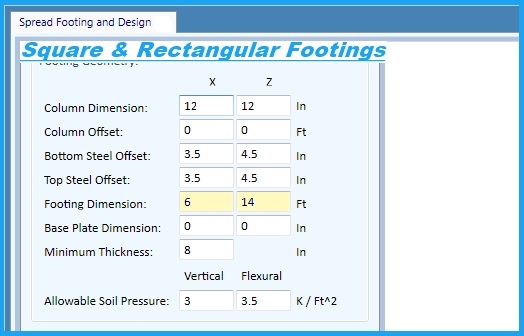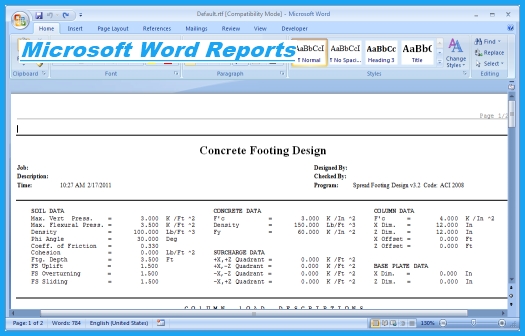- Updated Design Code to ACI 2019
- New load combinations as per ACI 2019
- Footings are designed to resist uplift and sliding forces as well as biaxial column moments and compressive forces.
- The all new “Vista-style” user-interface is more convenient and intuitive than ever!
- Footings are designed or checked using the latest ACI 318-2008 code.
- The controlling column and load combination is listed for each design criteria (footing dimensions, thickness, soil pressure, top steel, bottom steel)—helping you identify “problem columns” and verifying results.
- Enter up to ten column loads and find single footing that will work for all of the columns with one click of the mouse.
- Un-factored loads are input and factored for the latest ACI 2008 combinations; the combination list can be completely customized. Available load cases include dead, live, wind, earthquake, and roof (snow, rain, roof live) loads.
- Reinforcement design includes multiple bar size options and corresponding spacing. Minimum steel for temperature and shrink is determined and the user is warned if the footing becomes over-reinforced. When development is inadequate the program warns the user that anchorage must be provided.
- Column bearing is checked and the required area of dowel steel reported. If a baseplate is present, the bearing failure surface is adjusted accordingly.
- Design provisions for lightweight concrete.
- Dimension restrictions can be entered to control the design of the footing when space limitations are present. User defined increment factors assure that the program does not design footings of impractical size–no 46.5″ x 27.33″ footings!
- Reports are outstanding and provided in Microsoft Word format (RTF) giving you unequalled compatibility with other software.
- Flexible unit controls allow for US or metric designs.
- User defined “default data” lets you reduce the design of a footing to simply inputting the loads.
- Graphic “backgrounds” illustrate program input.
- The simple file format is small and makes projects easy to store, email, etc.
- User control of load combinations including ability to delete multiple load combinations at once
- Updated Design Code to ACI 2019
- New load combinations as per ACI 2019
- Footings are designed to resist uplift and sliding forces as well as biaxial column moments and compressive forces.
- The all new “Vista-style” user-interface is more convenient and intuitive than ever!
- Footings are designed or checked using the latest ACI 318-2008 code.
- The controlling column and load combination is listed for each design criteria (footing dimensions, thickness, soil pressure, top steel, bottom steel)—helping you identify “problem columns” and verifying results.
- Enter up to ten column loads and find single footing that will work for all of the columns with one click of the mouse.
- Un-factored loads are input and factored for the latest ACI 2008 combinations; the combination list can be completely customized. Available load cases include dead, live, wind, earthquake, and roof (snow, rain, roof live) loads.
- Reinforcement design includes multiple bar size options and corresponding spacing. Minimum steel for temperature and shrink is determined and the user is warned if the footing becomes over-reinforced. When development is inadequate the program warns the user that anchorage must be provided.
- Column bearing is checked and the required area of dowel steel reported. If a baseplate is present, the bearing failure surface is adjusted accordingly.
- Design provisions for lightweight concrete.
- Dimension restrictions can be entered to control the design of the footing when space limitations are present. User defined increment factors assure that the program does not design footings of impractical size–no 46.5″ x 27.33″ footings!
- Reports are outstanding and provided in Microsoft Word format (RTF) giving you unequalled compatibility with other software.
- Flexible unit controls allow for US or metric designs.
- User defined “default data” lets you reduce the design of a footing to simply inputting the loads.
- Graphic “backgrounds” illustrate program input.
- The simple file format is small and makes projects easy to store, email, etc.
- User control of load combinations including ability to delete multiple load combinations at once





